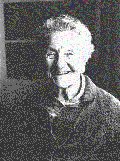

(1896 - 1991)
Born in 1896, Cynthia Longfield came from an Anglo-Irish family. She and her sisters had an enchanting lifestyle, sharing their time between their Cork home, at Castle Mary in Cloyne (18 miles from Cork city) and their London home. It was in the lush and fertile countryside of Cork that Cynthia Longfield developed an interest in plants, animals and insects.
Cynthia Longfield's home
in Castle Mary, Cloyne, Co.Cork
At the age of 14, Longfield became exasperated
with her education, and said to her mother "Must I go on
learning this absolute footling history?". Her mother asked
"what do you want to learn"?, "Science",
she replied. Luckily her mother understood this obsession, as her
father had been a man of science, and indulged her with books
from which she could teach herself natural history. Soon she had
progressed to
T.H.Huxley
books and
Charles Darwin
's
"Origin of the Species"
, which she loved. Besides science, she also had an interest in
the newly formed
Girl Guides
. She thoroughly enjoyed their
outdoor activities and remained involved with the movement for a
long time. She also loved to travel, and in her lifetime,
travelled extensively to
South America
,
Asia
and Africa. Cynthia Longfield's visits to her cousins in the
Oxfordshire countryside gave her great scope for collecting
butterflies
,
moths
and
dragonflies
. This interest in Natural
History suited her perfectly, the scientific method matching her
brilliant analytical mind, and the study of the wildlife allowing
her much time outdoors. After a visit to South America in 1921, Longfield
began work in the
British Natural History museum
. In 1924,
Longfield now keeper of the insect house at
London Zoo
, went on a
scientific expedition to the Pacific islands as assistant to
Cyril Collenette, a professional
entomologist
. He was to become
her only true love. Cynthia Longfield
and Cyril Collenette sailing on the St.George

Travels:

In 1925, she arrived back in London, a fully trained entomologist. In 1927, she went to Brazil, again with Cyril, this time chaperoned by her friend Gwen Dorrien-Smith. This was one of her most successful trips; it took over five months and in that time they covered 4,000 miles by land and along the coast, collecting many different species of dragonflies (Odonata) for the museum. At this time she began to focus her work on Odonata, which were not well researched at the time. Soon she became the museum's resident dragonfly expert and in time, an authority in her field.
Shortly after their return from Brazil, Longfield and Cyril Collenette decided, although very much in love, not to marry. This may have been due to Cyril's previous relationship with a Malaysian woman, with whom he fathered a child. In 1932, Longfield and her sister, while on holiday in Canada, rode on horseback through the Rockies through difficult ground and weather conditions.
Longfield had always travelled with a companion, but in 1934 at the age of 38, she decided to set off alone to Africa for six months. She brought back a substantial collection and much of her work at the Natural history museum was focused on this collection. In 1937, she published "The Dragonflies of the British Isles", a comprehensive and useful guide which became the standard handbook on identification of the British species. After publication of this book, she set off again for Africa, this time accompanied by Cecil Rhodes niece, Georgia.
Cynthia Longfield
with the Marquesans

On her travels she experienced every type of climate and wildlife and was used to strange faces, languages, customs and clothing. But in Africa, more than anywhere else, she took particular interest in the people, admiring the Masai people's tall figures and their jewellery. She fell in love with Uganda and before she left, she was involved in negotiations to buy a small coffee shamba there.
Masai people,
Tanzania, 1937

On arrival back in England in 1938, Europe was in crisis, World War 1 had begun. During the war she was posted to a fire station, appointed as officer in charge of 100 other women. Cyril Collenette wrote this of her at the time,
"during the war years she served with the fire fighting services and when an incendiary bomb fell on the Botany Department of the museum, she at once realised the gravity of the threat and was in a position to divert all resources to controlling the fire and her prompt action probably saved the whole museum from destruction".
In 1945, Longfield published the second enlarged edition of "The Dragonflies of the British Isles", which proved even more popular than the first. She was made an honorary associate of the museum in 1948, having worked there tirelessly for over 20 years. At the age of 60, she retired to a house on the edge of the Castle Mary Estate, at home in Cork.
As a result of her interests in botany and her work in Odonatology and Entomology , Cynthia Longfield saw most of Europe, and travelled extensively in four other continents, at a time when travel ment months at sea on a steamship. Retirement did not stop her travelling. Over the next few years she travelled to Holland, France, Greece, Malta, Moscow and to Australia at the age of 78, to various entomological conferences. In retirement, she published the book "Dragonflies" in 1960.
In 1987 she celebrated her 90th birthday. Although arthritis slowed her body down, her mind remained sharp. She died on June 27th 1991 and was buried in St.Coleman's Church of Ireland Cathedral, beside her home in Cloyne. A stone plaque commemorates her there.
Cynthia Longfield, aged 92
The
Royal Irish Academy
were presented with
Miss Longfield's library in 1979, and hope to put this on display
at some time in the future. 
![]()
![]()
![]()